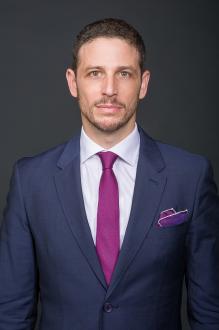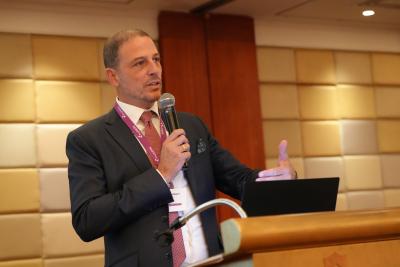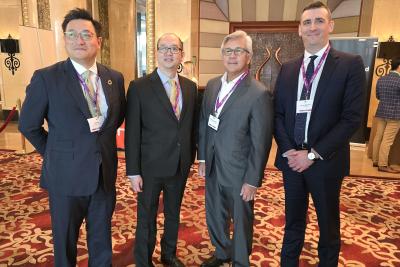The Compelling Case for Gold as a Core Holding in Asia’s HNW Portfolios

Joshua Rotbart of J. Rotbart & Co.
Jun 12, 2019
Joshua Rotbart, Founder and Managing Partner of precious metals firm J. Rotbart & Co. , is a passionate promoter of physical gold as a strategic and important asset in any serious high-net-worth investor’s portfolio. He addressed delegates at the Hubbis Philippines Wealth Management Forum with both an engaging introductory talk, and a detailed Workshop, to convey his unequivocal belief in physical gold. Joshua explained that physical gold is non-correlated to mainstream financial assets, it is an inflation hedge, it can easily be bought stored and insured outside the global financial system, it is highly liquid and, above all else, it has stood the test of the past several millennia as both a store and an enhancer of value.
Rotbart began by explaining that he and his Hong Kong-based team had for the past nine years been helping individuals, companies and financial institutions buy, sell, transport and store physical metals such as gold, platinum, palladium and silver.
“How many of you here have invested in physical gold?” he asked the delegates. “Not many, I see, and certainly not enough. So, I am here today to convince you to convince your clients that this is a must-own for today and for the future. I aim to give you the comfort of solid reasoning, as well as detailed information on the logistics involved.”
Gold’s many qualities
Rotbart then highlighted the ancient history and long ‘culture’ of gold, which since its first discovery has been a standard of prosperity. Gold, he said, is tangible and in an age where privacy is dying, gold and other tangible assets retain some privacy.
“Moreover,” he observed, “there is no cybersecurity risk. The risk of someone stealing from a secure storage location in Singapore or in Hong Kong and getting away is virtually zero. And if it does happen, it is insured.”
Gold is also trusted, it is liquid, governments buy and hold it, especially these days Russia, Kazakhstan, Turkey and China. It is therefore still a core part of our global monetary system, while not being directly exposed to financial intermediaries. It can be cashed in virtually anywhere in the world. And it is highly liquid, as investors can, for example, easily trade USD50 million in a swift phone call.
Gold is also excellent for wealth protection, as it is a stable earner with low volatility, Rotbart explained. “Gold appreciates over time and if you look at the volatility of gold compared to, for example, the S&P 500 Index, at the end of 1999, was at 1,458 and gold was priced at USD 290/ ozt. At the end of 2017 gold was at USD 1,291/ ozt while the S&P 500 was at 2,673 – A ratio of 4.45:1.83 (2.43:1). That is a remarkable outperformance. So, it is an excellent medium to long-term hold.”
A standard bearer of value
Gold had closed on May 15, the night before the Philippines Forum, at USD1,296 and had stood at around USD 909 roughly a decade earlier, while on May 1, 1999 stood at a shade over USD 273. On August 15, 1971, the date the US left the gold standard, gold traded at just over USD 35.
“Since the US went off the gold standard, gold has been performing very much in line with both US stocks and emerging markets, and performs far better than cash,” Rotbart reported. “Moreover, if you look at how gold performs in times of market stress, it performs remarkably well when equity markets are going down and at times of global financial stress, so it provides the hedge, the cushion, for your clients to reduce volatility and manage the risks. And as it is outside the global banking and financial system, there is no counterparty risk. Accordingly, it is an excellent tool for wealth protection. In short, one can see it as an investment and as an insurance policy.”
He also highlighted how USD 35 cash in 1970 is equivalent to roughly USD 250 today, inflation adjusted. “Well,” Rotbart noted, “you can see how gold as a cash substitute performs far better than cash, as today's price around USD 1300 is more than five times higher than the adjusted cash price.”
He also highlighted a few data points to show gold’s capacity as a portfolio diversifier. “Performance during the October 1987 global equity crash was remarkable,” he reported, “and then 9/11 the S&P collapsed by 22% and gold surged 16%, then see more recently the stresses over China in 2015-16, when gold rose 11 % and the S&P fell about 12%. There are many other examples over the past decades.”
Buy the physical
He moved on to why HNWIs should buy physical rather than paper gold. “Even the best gold ETFs are not backed 100% with physical gold,” he reported. “Even the very best ETFs, and I won’t name names, only keep 90% backing maximum backing in gold, and the average is lower, as they use derivatives and other instruments to maintain the daily fluctuations. We therefore strongly urge clients who want to do more than simply speculate on gold prices to buy physical for medium to long term holdings. If the ETFs had to be redeemed, they simply would not have enough gold to cover that.”
He then touched on the relevance to the wealth management market in the Philippines. “The economy is buoyant,” he commented, “and the wealth management industry is expanding and growing more sophisticated. But there are some concerns - inflation is relatively high and the Peso is depreciating at a steady pace of about 2% a year, so, as gold is a US dollar asset this is an ideal hedge. We have an office in Manila, and right in front of me here today is one of the major local private banks that has become the first local bank to offer the clients physical gold, so congratulations.”
Rotbart explained that for wealth management experts, to offer gold adds to their suite of products and ideas, bringing in non-mainstream concepts and an additional creative solution. “Your clients appreciate when you offer something that is not necessarily linked to your institution. And you can make money from it, as there are transaction fees, storage fees and other recurring fees.”
Fun facts
He then offered what he called some fun facts. He explained that to date, in the history of the world, an estimated 187,000 tonnes of gold has been mined valued today at about USD7 trillion dollars. “And if you put it in a cube, it would measure no more than 21 metres cubed. Gold has very robust demand and very limited supply.”
He added that annual mining produces about 3400 tonnes a year, and that supply is supplemented by recycling. “Yes, you can melt down jewellery or other artefacts, with no loss of material,” he noted. “There was gold in the basement of the World Trade Centre on 9/11 and they managed to recover virtually all of it.”
Liquidity excels
“Just this past Monday,” he told the delegates, “I sold some unit trusts by one of the biggest banks in Hong Kong, and expecting the money the next day, I was then told I must wait T+6 days, as liquidity was not available, despite the bank being a global major.”
During that time, Rotbart was exposed to the financial intermediary risks and could not reinvest his money. “But gold is liquid, so even if you trade USD50 million at one shot, the settlement can be done in a matter of a day” he reported. “When the economies are good, people buy jewellery. When the economy is bad, people buy coins and bars as investment. There is continuous, very robust demand.”
Not so fun facts
There are political and economic dangers that gold can sidestep. “Look at Cyprus in March 2013,” he noted. “During the 2012-13 financial problems there, in exchange for EU financial support, Cyprus levied a ‘one-time’ tax on bank deposits in March 2013. That is a frightening thought. But gold is in your name, it is stored outside the financial system, it is safe, secure, insured, and fully accessible if you want to get physical possession of it. There is no counterparty risk, and it is an ideal hedge against your own currency risk, and as we have seen many times in history, currencies can collapse.”
Privacy rules
He expounded on the ownership, explaining physical gold can be held confidentially. “Clients still appreciate privacy, not necessarily because they’re trying to hide anything,” he commented, “but because they might not want everything so public. It also has a security impact on high-wealth families.”
And as to storage, there are facilities around the world, including state-of-the-art storage in Singapore and Hong Kong. “Regulations mean we cannot bring gold into the Philippines, so it is stored offshore. You know, you can’t take a building with you in a crisis, but you could access your gold, so it is better to have some tangible assets offshore, and that could be Singapore, Hong Kong, Switzerland, New Zealand, the UK, Switzerland, the US and other primate, secure locations around the globe.”
How much is enough?
As to how much of any portfolio investors should hold in physical gold, Rotbart cited Ray Dalio, Founder of Bridgewater Associates, who he said is on the record as having stated: “...Most people should have roughly 10% of their assets in gold, not only as a good, long-term investment, but also for its effectiveness in diversifying the other 90% of assets people hold...”
Rotbart elucidated on why gold is an excellent tool for portfolio diversification. “As a guide, we believe most of our clients hold between 3% to 10% of their assets in physical metals; gold is considered a very good hedge, because historically when the market falls gold will usually fare better.”
Bullion – unique and identifiable
Turning in more detail on how to buy and hold gold, Rotbart explained that each precious metal bar has four identifying marks: the hallmark (from the refiner), the weight, the purity and the unique serial number. “At any given point owners are able and even encouraged to visit the vault and check these markers and their holdings,” he explained.
Rotbart noted that customers also like to know where the best vaults are located and choose their preferred location(s). “Where do people feel safe?” he asked, rhetorically. “Whatever the location, whether Singapore, Hong Kong, Switzerland, UK, Canada, we advise clients to put it where they feel secure, where they feel comfortable visiting and to also diversify locations if they have very large holdings.”
The vault must have a top-flight liability policy, especially for transportation. The London Bullion Market Association (LBMA), which monitors the gold and silver market globally, also auditing vault operators, refiners, dealers and so forth. “This ecosystem we call - the Chain of Integrity,” Rotbart explained.
With that, Rotbart passed around a gold bar. He explained that investors, especially in Asia usually buy the one-kilogram bar because they are liquid, and as each is worth roughly USD 40,000, it is easy for the clients to assess value. And some buy coins, as well, which can be sold roughly in USD 13,000 increments, as each one weighs one troy ounce.
Segregated and off-balance sheet
Gold is not commingled. “Your gold is stacked separately from the other clients’ gold. Your gold is therefore allocated by client name, so the buying and selling related directly to the serial numbers of the gold bars.”
The bullion is also distinct from the storage company. “It cannot be leveraged or used in any form as collateral by the storage or logistics companies,” he explained.
He added that inspection is also important. “Here in Manila we are working with BDO Private Bank now, and clients are fully reassured. We pay for a third party auditor to come every year to all the vaults globally and inspect the gold for all clients, at no extra charge.”
A seamless and professional service
Rotbart’s final words were on his company. “We are a family business,” he explained. “My brother is here today as well, we are based in Hong Kong and we also have presence in Singapore and now also in the Philippines for the last few months. We offer storage in 10 locations globally and deliver in 35 locations globally.”
He added that he had worked before for the biggest vault operator in Asia, and has deep experience of the security, insurance, customs clearance, and all facets relating to logistics in physical gold. “We also know all the refiners, all the dealers, we know this ecosystem very well. The minimum transaction is usually USD200,000, but working with BDO in the Philippines the minimum is USD100,000. And our greatest pleasure is when our clients tell us how easy it all was and how efficient we had been in working on their behalf. Thank you.”
“Gold is money, everything else is credit” (J.P. Morgan, 1912)

Managing Partner at J. Rotbart & Co.
More from Joshua Rotbart, J. Rotbart & Co.
Latest Articles






